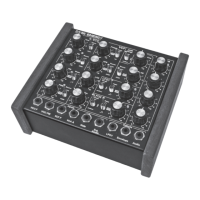The symmetrical pulsewave(or“squarewave”,pulsewidth=
50%)containsoddharmonicsonly(seeFig.).Anunsymmetrical
pulsewave(oftensimplycalled“pulsewave”)containsallharmon-
icswiththeiramplitudesbeingdependantonthepulsewidth.
Themorethepulsewidthdiffersfromthesymmetrical50%,the
strongerthehigherharmonicsembossthesound,i.e.itstimbre
becomesmore“nasal”.
The width of a pulsewavecanbemodulatedbyalowfrequency
oscillator(LFO)or,lesscommon,byanenvelopegenerator.Then
theovertonespectrumofthepulsewavecontinuouslychanges.
Theresultingsoundissimilartoabeatwavewhichistheresult
oftwo,nearlyequallytunedoscillators.Themodulationfrequency
mustbeverylow(approx.1Hzorlower)sincetheoscillator
seemsdetunedotherwise.
The triangleandsinewaveformshaveonlyaweaklypronounced
harmonicstructureresp.noharmonicsatall(sine).Thetriangle
waveformcontainsonlytheoddharmonicslikethesawtoothbut
theiramplitudesdecreasesbythepoweroftwowhilewiththe
sawtooththeyaredecreasinglinearelyintheirnumericalorder
andthereforemuchslower.
Modulation
Theamountofovertonesofthebasematerialisdecisiveforthepossibilitiesinsoundshapingwiththesub-
sequentvoltage-controlledlter(VCF)sincesubtractivesoundsynthesiswithaVCF(seebelow)onlyal-
lowstocut-outoramplifyovertonesthatexist.Therefore,thesineandtrianglewaveonlyplayaminorpart
here.UndertheconditionthataVCFworksassinewaveoscillatorwhenresonanceissettomaximum,it
canbeusedinthiswayifasinewaveoscillatorisrequiredforaspecialsound.
Ifalowfrequencyoscillatorisavailable,itcanbeusedformodulating
eithertheVCOpitch(frequencymodulation=FM,alsocalled“vibrato”)
orthepulsewidth(pulsewidthmodulation=PWM).SimpleLFOsprovide
frequenciesintherangeof0.1Hzto10Hzwhilebetteroneshaveasig-
nicantlywiderrange(0.01Hzto5kHz)withswitchablefrequencybands
forbetteradjustment.
Modulationfrequencieswithintheaudiorangeshouldbedealtwithinmoredetailsincetheirresultarevery
specialsounds.IfaVCOismodulatedwithafrequencyclosetoitsown,acompletelynewsoundcharac-
teristicisestablished.InthiscasetheVCOalsoproducesnon-harmonics,i.e.toneswhosefrequenciesare
non-integermultiplesoftheVCOfrequency.Thisacousticalcharacteristicisthebasisfortheso-calledFM
Synthesiswhichisusedwithseveraldigitalsynthesizers.Ife.g.aVCO,oscillatingat1kHz(1000Hz),is
modulatedwithafrequencyof400Hz,so-called“sidebands”aroundthetheVCOfrequencyarecreated
whicharegroupedsymmetricallyaroundtheVCOfrequencyasintegermultiplesofthemodulation

